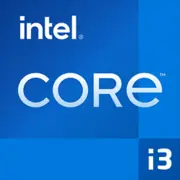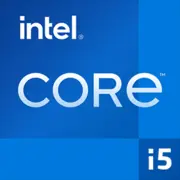Intel Core i3-10100 vs Intel Core i5-4690K
CPU-Vergleichsergebnis
Nachfolgend finden Sie die Ergebnisse eines Vergleichs von
Intel Core i3-10100
und
Intel Core i5-4690K
Prozessoren basierend auf wichtigen Leistungsmerkmalen sowie Stromverbrauch und vielem mehr.
Vorteile
- Höher Maximale Turbofrequenz: 4.30 GHz (4.30 GHz vs up to 3.9 GHz)
- Höher Herstellungsprozess: 14 nm (14 nm vs 22 nm)
- Neuer PCI-Express-Version: 3.0 (3.0 vs Gen 3)
- Höher Speichertypen: DDR4-2666 (DDR4-2666 vs DDR3)
- Neuer Erscheinungsdatum: April 2020 (April 2020 vs June 2014)
Basic
Intel
Markenname
Intel
April 2020
Erscheinungsdatum
June 2014
Desktop
Plattform
Desktop
i3-10100
Modellname
?
Die Anzahl der Intel-Prozessoren ist neben der Prozessormarke, den Systemkonfigurationen und Benchmarks auf Systemebene nur einer von mehreren Faktoren, die bei der Auswahl des richtigen Prozessors für Ihre Computeranforderungen berücksichtigt werden müssen.
Core i5-4690K
Comet Lake
Kernarchitektur
Haswell
-
Generation
Core i5 (Haswell)
CPU-Spezifikationen
4
Gesamtzahl der Kerne
?
Kerne ist ein Hardwarebegriff, der die Anzahl unabhängiger Zentraleinheiten in einer einzelnen Computerkomponente (Chip oder Chip) beschreibt.
4
8
Gesamtzahl der Threads
?
Wo zutreffend, ist die Intel® Hyper-Threading-Technologie nur auf Performance-Kernen verfügbar.
4
3.60 GHz
Grundfrequenz
3.5 GHz
4.30 GHz
Maximale Turbofrequenz
?
Die maximale Turbofrequenz ist die maximale Single-Core-Frequenz, mit der der Prozessor mit Intel® Turbo Boost-Technologie und, falls vorhanden, Intel® Turbo Boost Max Technology 3.0 und Intel® Thermal Velocity Boost arbeiten kann. Die Frequenz wird typischerweise in Gigahertz (GHz) oder Milliarden Zyklen pro Sekunde gemessen.
up to 3.9 GHz
No
Intel Turbo Boost Max Technology 3.0
?
Intel® Turbo Boost Max Technology 3.0 identifies the best performing core(s) on a processor and provides increased performance on those cores through increasing frequency as needed by taking advantage of power and thermal headroom.
-
Yes
Intel Hyper-Threading Technology
?
Intel® Hyper-Threading Technology (Intel® HT Technology) delivers two processing threads per physical core. Highly threaded applications can get more work done in parallel, completing tasks sooner.
-
4.30 GHz
Intel Turbo Boost Technology 2.0 Frequency
-
2.0
Intel Turbo Boost Technology
?
Intel® Turbo Boost Technology dynamically increases the processor's frequency as needed by taking advantage of thermal and power headroom to give you a burst of speed when you need it, and increased energy efficiency when you don’t.
-
-
L1-Cache
64 KB (per core)
-
L2-Cache
256 KB (per core)
6 MB
L3-Cache
6 MB (shared)
-
Multiplier Unlocked
Yes
-
Multiplikator
35.0x
-
Bus-Frequenz
100 MHz
FCLGA1200
Sockel
?
Der Sockel ist die Komponente, die die mechanischen und elektrischen Verbindungen zwischen Prozessor und Motherboard herstellt.
Intel Socket 1150
14 nm
Herstellungsprozess
?
Lithographie bezieht sich auf die Halbleitertechnologie, die zur Herstellung eines integrierten Schaltkreises verwendet wird, und wird in Nanometern (nm) angegeben, was die Größe der auf dem Halbleiter aufgebauten Strukturen angibt.
22 nm
65 W
Thermal Design Power (TDP)
88 W
100°C
Maximale Betriebstemperatur
?
Die Sperrschichttemperatur ist die maximal zulässige Temperatur am Prozessorchip.
-
3.0
PCI-Express-Version
?
PCI Express Revision ist die unterstützte Version des PCI Express-Standards. Peripheral Component Interconnect Express (oder PCIe) ist ein Hochgeschwindigkeitsstandard für serielle Computererweiterungsbusse zum Anschließen von Hardwaregeräten an einen Computer. Die verschiedenen PCI-Express-Versionen unterstützen unterschiedliche Datenraten.
Gen 3
16
Anzahl der PCI-Express-Lanes
?
Eine PCI Express (PCIe)-Lane besteht aus zwei differenziellen Signalpaaren, eines zum Empfangen von Daten, eines zum Senden von Daten, und ist die Grundeinheit des PCIe-Busses. Max. Anzahl der PCI Express-Lanes ist die Gesamtzahl der unterstützten Lanes.
-
Yes
Intel 64
?
Intel® 64 architecture delivers 64-bit computing on server, workstation, desktop and mobile platforms when combined with supporting software.¹ Intel 64 architecture improves performance by allowing systems to address more than 4 GB of both virtual and physical memory.
-
64-bit
Befehlssatz
?
Der Befehlssatz ist ein hartes Programm, das im CPU gespeichert ist und die CPU-Operationen leitet und optimiert. Mit diesen Befehlssätzen kann die CPU effizienter arbeiten. Es gibt viele Hersteller, die CPUs entwerfen, was zu verschiedenen Befehlssätzen führt, wie dem 8086-Befehlssatz für das Intel-Lager und dem RISC-Befehlssatz für das ARM-Lager. x86, ARM v8 und MIPS sind alle Codes für Befehlssätze. Befehlssätze können erweitert werden; zum Beispiel fügte x86 64-Bit-Unterstützung hinzu, um x86-64 zu erstellen. Hersteller, die CPUs entwickeln, die mit einem bestimmten Befehlssatz kompatibel sind, benötigen die Genehmigung des Befehlssatz-Patentinhabers. Ein typisches Beispiel ist Intel, das AMD autorisiert, um CPUs zu entwickeln, die mit dem x86-Befehlssatz kompatibel sind.
-
Up to 1x16 | 2x8 | 1x8+2x4
PCI Express Configurations
?
PCI Express (PCIe) Configurations describe the available PCIe lane configurations that can be used to link to PCIe devices.
-
-
Transistors
1,400 million
Speicherspezifikationen
DDR4-2666
Speichertypen
?
Intel®-Prozessoren gibt es in vier verschiedenen Typen: Single Channel, Dual Channel, Triple Channel und Flex Mode. Die maximal unterstützte Speichergeschwindigkeit kann niedriger sein, wenn bei Produkten, die mehrere Speicherkanäle unterstützen, mehrere DIMMs pro Kanal bestückt werden.
DDR3
128 GB
Maximale Speichergröße
?
Die maximale Speichergröße bezieht sich auf die maximale vom Prozessor unterstützte Speicherkapazität.
-
2
Maximale Anzahl an Speicherkanälen
?
Die Anzahl der Speicherkanäle bezieht sich auf den Bandbreitenbetrieb für reale Anwendungen.
Dual-channel
41.6 GB/s
Maximale Speicherbandbreite
?
Max Memory bandwidth is the maximum rate at which data can be read from or stored into a semiconductor memory by the processor (in GB/s).
-
8 GT/s
Busgeschwindigkeit
-
No
ECC Memory Supported
?
ECC Memory Supported indicates processor support for Error-Correcting Code memory. ECC memory is a type of system memory that can detect and correct common kinds of internal data corruption. Note that ECC memory support requires both processor and chipset support.
-
-
ECC Memory
No
GPU-Spezifikationen
Intel® UHD Graphics 630
Integrierte GPU
?
Eine integrierte GPU bezieht sich auf den Grafikkern, der in den CPU-Prozessor integriert ist. Durch die Nutzung der leistungsstarken Rechenfähigkeiten und intelligenten Energieeffizienzverwaltung des Prozessors bietet sie eine hervorragende Grafikleistung und ein flüssiges Anwendungserlebnis bei geringerem Stromverbrauch.
Intel HD 4600
1.10 GHz
Grafikfrequenz
?
Die maximale dynamische Grafikfrequenz bezieht sich auf die maximale opportunistische Grafik-Rendering-Taktfrequenz (in MHz), die mit Intel® HD Graphics mit Dynamic Frequency-Funktion unterstützt werden kann.
-
350 MHz
Graphics Base Frequency
?
Graphics Base frequency refers to the rated/guaranteed graphics render clock frequency in MHz.
-
64 GB
Graphics Video Max Memory
-
Yes | at 60Hz
4K Support
-
12
DirectX Support
?
DirectX* Support indicates support for a specific version of Microsoft’s collection of APIs (Application Programming Interfaces) for handling multimedia compute tasks.
-
4096 x 2304@60Hz
Max Resolution (eDP - Integrated Flat Panel)
?
Max Resolution (Integrated Flat Panel) is the maximum resolution supported by the processor for a device with an integrated flat panel (24bits per pixel & 60Hz). System or device display resolution is dependent on multiple system design factors; actual resolution may be lower on your device.
-
4096 x 2304@60Hz
Max Resolution (DP)
?
Max Resolution (DP) is the maximum resolution supported by the processor via the DP interface (24bits per pixel & 60Hz). System or device display resolution is dependent on multiple system design factors; actual resolution may be lower on your system.
-
4096 x 2160@30Hz
Max Resolution (HDMI)
?
Max Resolution (HDMI) is the maximum resolution supported by the processor via the HDMI interface (24bits per pixel & 60Hz). System or device display resolution is dependent on multiple system design factors; actual resolution may be lower on your system.
-
3
Number of Displays Supported
-
Verschiedenes
Yes
Intel Virtualization Technology for Directed I/O (VT-d)
?
Intel® Virtualization Technology for Directed I/O (VT-d) continues from the existing support for IA-32 (VT-x) and Itanium® processor (VT-i) virtualization adding new support for I/O-device virtualization. Intel VT-d can help end users improve security and reliability of the systems and also improve performance of I/O devices in virtualized environments.
-
Yes
Intel Virtualization Technology (VT-x)
?
Intel® Virtualization Technology (VT-x) allows one hardware platform to function as multiple “virtual” platforms. It offers improved manageability by limiting downtime and maintaining productivity by isolating computing activities into separate partitions.
-
Intel® SSE4.1 | Intel® SSE4.2 | Intel® AVX2
Intel Standard Manageability (ISM)
?
Intel® Standard Manageability is the manageability solution for Intel vPro® Essentials platforms and is a subset of Intel® AMT with out-of-band management over Ethernet and Wi-Fi, but no KVM or new life cycle management features.
-
Yes
Enhanced Intel SpeedStep Technology
?
Enhanced Intel SpeedStep® Technology is an advanced means of enabling high performance while meeting the power-conservation needs of mobile systems. Conventional Intel SpeedStep® Technology switches both voltage and frequency in tandem between high and low levels in response to processor load. Enhanced Intel SpeedStep® Technology builds upon that architecture using design strategies such as Separation between Voltage and Frequency Changes, and Clock Partitioning and Recovery.
-
Yes
Execute Disable Bit
?
Execute Disable Bit is a hardware-based security feature that can reduce exposure to viruses and malicious-code attacks and prevent harmful software from executing and propagating on the server or network.
-
6 MB Intel® Smart Cache
Cache
?
CPU Cache is an area of fast memory located on the processor. Intel® Smart Cache refers to the architecture that allows all cores to dynamically share access to the last level cache.
-
Yes
Intel AES New Instructions
?
Intel® AES New Instructions (Intel® AES-NI) are a set of instructions that enable fast and secure data encryption and decryption. AES-NI are valuable for a wide range of cryptographic applications, for example: applications that perform bulk encryption/decryption, authentication, random number generation, and authenticated encryption.
-
Yes
Intel Boot Guard
?
Intel® Device Protection Technology with Boot Guard helps protect the system’s pre-OS environment from viruses and malicious software attacks.
-
Yes
Intel Clear Video HD Technology
?
Intel® Clear Video HD Technology, like its predecessor, Intel® Clear Video Technology, is a suite of image decode and processing technologies built into the integrated processor graphics that improve video playback, delivering cleaner, sharper images, more natural, accurate, and vivid colors, and a clear and stable video picture. Intel® Clear Video HD Technology adds video quality enhancements for richer color and more realistic skin tones.
-
Yes
Intel Clear Video Technology
-
Yes
Intel VT-x with Extended Page Tables (EPT)
?
Intel® VT-x with Extended Page Tables (EPT), also known as Second Level Address Translation (SLAT), provides acceleration for memory intensive virtualized applications. Extended Page Tables in Intel® Virtualization Technology platforms reduces the memory and power overhead costs and increases battery life through hardware optimization of page table management.
-
Yes
Intel InTru 3D Technology
-
Yes
Intel OS Guard
-
4.5
OpenGL Support
?
OpenGL (Open Graphics Library) is a cross-language, multi-platform API (Application Programming Interface) for rendering 2D and 3D vector graphics.
-
Yes
Intel Quick Sync Video
?
Intel® Quick Sync Video delivers fast conversion of video for portable media players, online sharing, and video editing and authoring.
-
Benchmarks
Geekbench 6 Einzelkern
Core i3-10100
1423
+12%
Core i5-4690K
1273
Geekbench 6 Mehrkern
Core i3-10100
4224
+20%
Core i5-4690K
3508
Geekbench 5 Einzelkern
Core i3-10100
1081
Core i5-4690K
1154
+7%
Geekbench 5 Mehrkern
Core i3-10100
3786
+0%
Core i5-4690K
3770
Passmark CPU Einzelkern
Core i3-10100
2593
+18%
Core i5-4690K
2195
Passmark CPU Mehrkern
Core i3-10100
8774
+54%
Core i5-4690K
5688


